Describing a Guitar is very easy. It has a head, neck, and body, just like humans. But as we are more than just a body, the Guitar is more than a box that produces sound when strings are plucked. It’s not only six strings, it creates soothing melodies and sentiments.
The chords, especially the Minor chords are melodious and complex at the same time. It’s a skill to play and ace them. So, let’s start with the first chord and learn How to Play A Minor on Guitar.
Which Scale is Used to Play A Minor Chord?
The A minor scale is used to play Am chord. If you want to learn A Minor on Guitar, you first need to know A Minor scale.
The A Minor scale starts with an A note. That means the root note is A. A Minor scale includes following notes – A B C D E F G A.
Interval structure for A minor scale: Whole step – Half step – Whole step – Whole step – Half step – Whole step – Whole step
Interestingly, A Minor scale has notes similar to C Major scale. Let’s see how.
A Minor – A B C D E F G A
C Major – C D E F G A B C
Though they include the same series of notes, the root note is different in both. If you know how to play C major scale, you will easily get hold of A minor scale.
In case you are a newbie, you need to have a basic understanding of:
A Minor Chord Family
Chord families include chords that are derived from the scale and go perfect together. For the Am chord, the chord family is Am, G Major, and F Major.
Now, let’s move ahead and learn the skill of playing A Minor on Guitar.
How to Play A Minor on Guitar?
There are different ways to play A Minor chord. The most commonly used variation is the Standard A Minor guitar chord.
Standard A Minor Guitar Chord
- Place your first finger (Index finger) on the 2nd string (B string) of the 1st fret.
- Now, place your 3rd finger (Ring finger) on the 3rd string (G string) of the second fret.
- On the same fret, place your 2nd finger (Middle finger) on the 4th string (D string).

NOTE: For any A chord, we strum from the 5th string (A string). We don’t strum the 6th string (Low E string).
The chord diagram of the Standard A Minor guitar chord with an open position is identical to the E Major chord, as shown below. Hence, once you learn how to play Standard A Minor, you can also play the E Major chord.
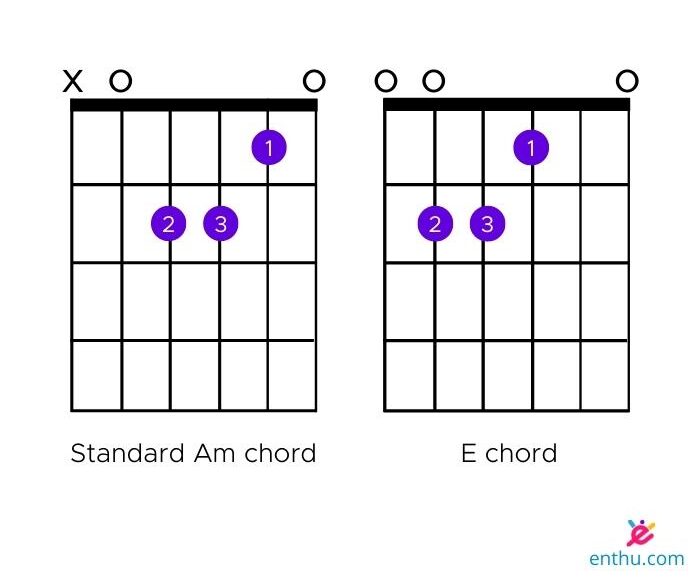
Playing the Standard A Minor chord is not tricky. But for beginners, it takes some time to gain control and agility to play the chords.
Let’s look at some variations of the A Minor chord and finger positions.
A Minor 7 Chord
It’s an easier version to play Am. So, Am 7 can be used as a substitute for the Am chord and vice versa.
- Place your first finger (Index finger) on the 2nd string (B string) of the 1st fret.
- Now, place your 2nd finger (Middle finger) on the 4th string (D string) of the second fret.
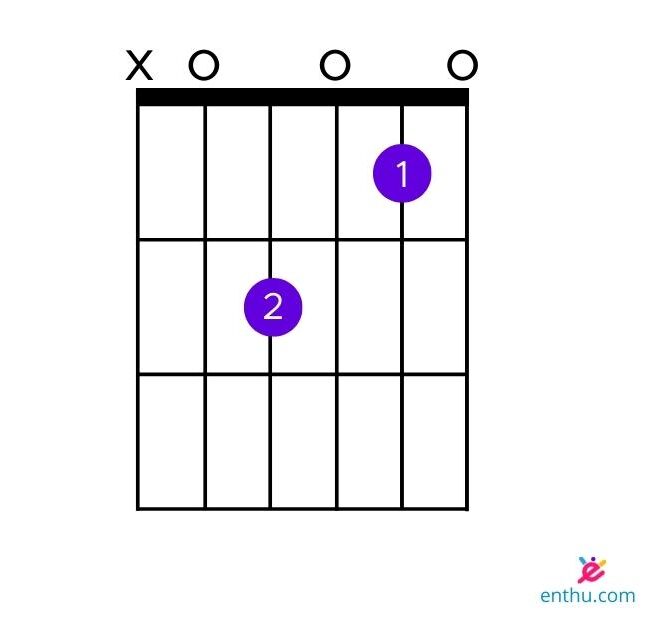
Remember, do not strum the 6th string (Low E string).
Check out EnthuZiastic Guitar Classes for a personalized Guitar learning experience.
Let’s know some other variations.
Variations of A Minor Chord
Variation 1
This version of Am chord might sound slightly different, but it serves the purpose. It has the same minor chord shape as the Am 7.
- Place your first finger (Index finger) on the 2nd string (B string) of the 1st fret.
- Finally, place your 2nd finger (Middle finger) on the 3rd string (G string) of the 2nd fret.
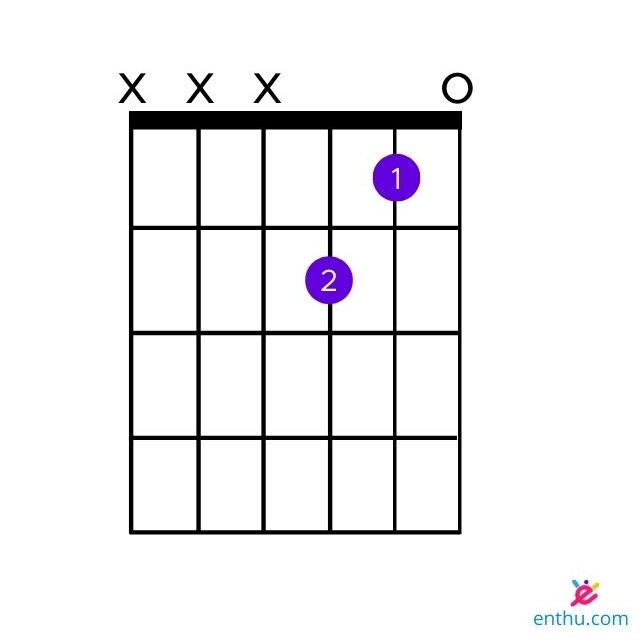
NOTE: Skip the 4th string (D string), 5th string (A string), and 6th string (Low E string) while strumming.
Variation 2
This is the easiest version of the Am chord.

NOTE: Remember to play only the first 2 strings, High E string and B string.
Variation 3
This is another easy variation where you place fingers on the same fret.
- Moving to the 5th fret, place your 1st finger (Index finger) on the 3rd string (G string).
- Place your 2nd finger (Middle finger) on the 2nd string (B string) of the 5th fret.
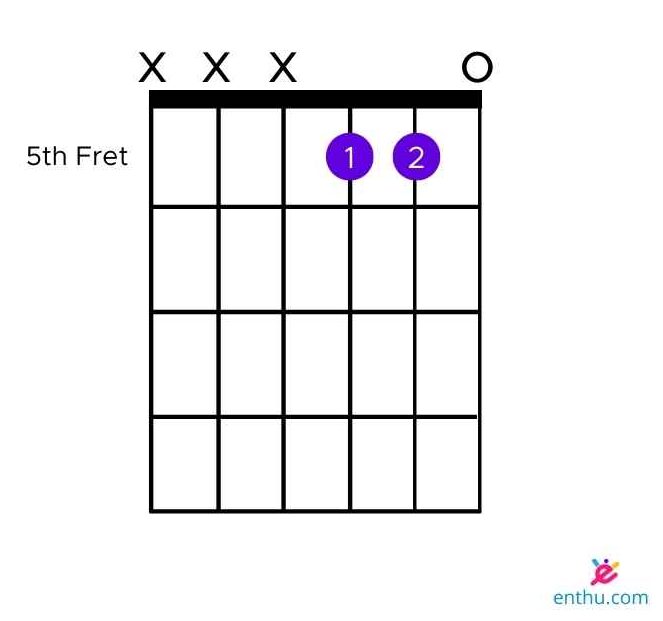
NOTE: Only play the first 3 strings, E High string, B string, and G string.
Variation 4
This variation is very much similar to the 4th method. Use only one fret to place the strings and play the chord.
- Place your 1st finger (Index finger) on the 3rd string (G string) of the 5th fret.
- Now, place your 2nd finger (Middle finger) on the 2nd string (B string) of the same fret.
- Further, place your 3rd finger (Ring finger) on the 1st string (E High String) of the same fret.

NOTE: Skip the last 3 strings (D, A, and Low E String) and play the only first 3 strings, E High string, B string, and G string.
All the variations of Am chord are easy to play. You don’t have to outstretch your fingers as you do in a Barre Chord. The best part is, all the chord shapes in every version are close to each other. So, if you learn only one variation and practice, you can play the rest of the variations as well.
Get Your Guitar Posture Right
Keep away from physical strain and back pain with these tips to maintain correct posture.
A Minor Chord Progression Guitar
If you are a beginner guitar player, you might not know this term. Chord Progression refers to two or more chords played in a specific series. This series can create numerous melodies and expressions.
Chord Progressions are played with a particular approach and style. You can understand the trick by learning the correct technique for playing the notes on guitar fretboard.
Let’s see some of the A Minor chord progressions:
- Am – F Major – C Major – G Major
- Am – G Major – F Major
- Am – D Minor – G Major – F Major
- Am – Em – Dm – G Major
Minor chords and progressions do sound sad or restless. But they pour emotions and flavors, and create a melody that makes the listener remember moments of life.
A Minor is a popularly used chord. You will find numerous popular songs having a base of A Minor. A variety of power chord song genres like Rock, folk, pop, blues, and country songs have beautifully used Am. Let’s know some of the famous songs.
Famous Songs Based on A Minor Chord
- “This is what you came for” by Calvin Harris and Rihanna is a beautiful song based on A Minor.
- “The Pretender” by Foo Fighters is an energetic Rock song in A Minor that keeps the emotions alive.
- “All of me” by American singer and songwriter John Legend, is a highly catchy Pop song with A Minor.
A minor is a beginner-friendly chord. It is one of the basic chords you get to learn as beginner guitarists. Even if you are starting out, basic knowledge of notes and playing techniques helps you to play any chord. This way you can learn to sing and play the guitar at the same time.
FAQs
Why do I get a buzzing sound while playing chords?
This is because you are not pressing the strings with the proper pressure. As a beginner, it takes time to develop a grip. You juggle between the strings and chord shape. That’s why you can’t press the strings properly and get a faint sound. Go slow. Make sure you are pressing the correct strings with optimum pressure.
Is it easy for a beginner to make chord transitions?
Anyone can make smooth and easy chord transitions, but with PRACTICE. Understanding and practicing guitar chords becomes easy when you are familiar with chord shapes. Hence, practice the shapes, visualize the chords, and learn the proper technique of playing chords. Once you get used to them, you can easily make chord transitions.
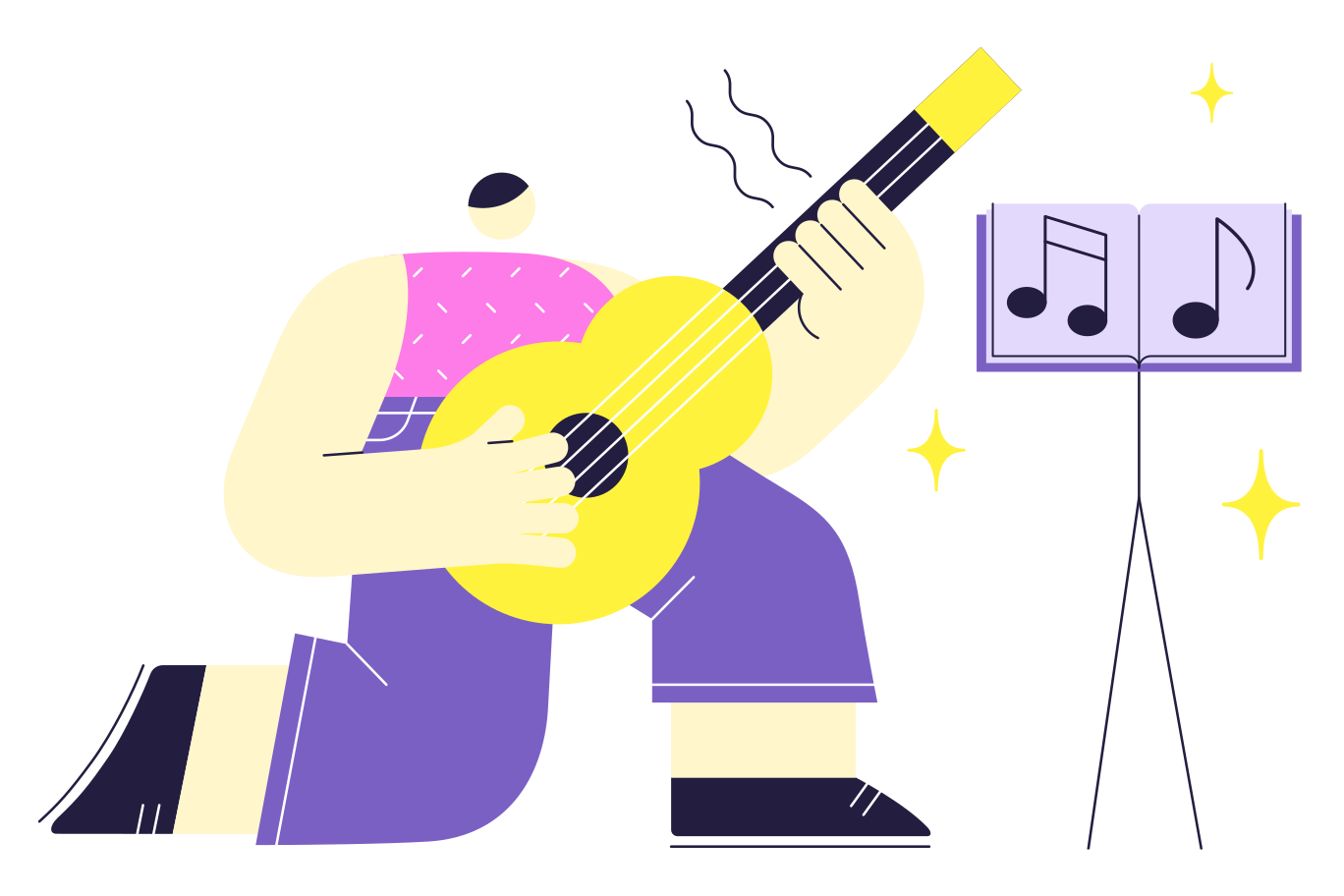
Learn Guitar From Expert Teachers
Book a free demo class with one of our top teachers and start learning Guitar.
Conclusion
A Minor is a sentimental yet melodious guitar chord. A remarkable thing about this chord is, you can create many genres with it, and it will give an identity to the composition. A Minor has depth and a powerful personality. Thus, this is one of the most loved chords by musicians.
You must be waiting to hold your guitar and start learning Am chord. Well, I recommend not to go in a rush. You can surely self-learn. But the proper guidance of an expert to meet your goal is essential.
So, Keep learning. Keep practicing. Keep experimenting!

